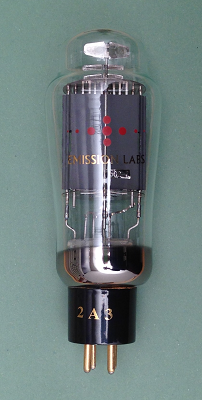2A3-S Data Sheet
Description
 |
The EML2A3-S is a plug & play, direct replacement for original the RCA 2A3 tube. It will bias exactly at the original operating point. Yet, for higher power applications, this tube can be used as well. At higher plate dissipation, it is possible to bias the tube up to 28Watt dissipation, which Single-Ended, will give 9.3 Watt RMS output. |
Guarantee program for first owner.
The first owner can register the tube at the Emission Labs website, to participate in the 5 years guarantee program. Lifetime of the 2A3-S is estimated comparable to the EML45 tube.
Sound Character of the EML 2A3-S
First, if used at standard 2A3 bias, this tube must be compared with the RCA single plate version.
The second application is using this tube at higher dissipation. This will give higher output power, up to 9.3 Watt, and if compared with a standard application, at the SAME output power, distortion will be much lower. The robustness of the 2A3-S is remarkable, and it is excellently suited for Push-Pull design as well.
All critical parts, like filaments and grids are made of hard metal for higher reliability and reproducible quality. The tube base is now glued on the glass with anti-vibration rubber.
2A3-S Filament Ratings |
|
| Filament Voltage | |
| Tolerance on filament voltage | 2.4 ... 2.6V at Tube pins 2.5 ... 2.7V at Socket pins See also this graph |
| Filament Current | |
| Anode Voltage | |
| Anode Current | |
| Anode Dissipation Continuous | |
| Anode Dissipation Peak (30minutes) | |
| Power Output in Class A | |
Highest possible Grid to ground resistor, Single Ended. |
|
Highest possible Grid to ground resistor, Push-Pull. |
|
2A3-S Factory Test conditions |
|
| Anode Voltage | |
| Anode Current | |
| Control Grid Voltage | |
| Transconductance | |
2A3-S Typical Data (1) |
|
| Anode Voltage | |
| Anode Dissipation | |
| Anode Current | |
| Control Grid Voltage | |
| Anode Impedance (Rp) | |
| Amplification Factor | |
| Transconductance (Gm) | |
| Load Impedance (Ra) | |
| Power Output @ Ra = 2500k | |
2A3-S Typical Data (2)
|
|
| Anode Voltage | |
| Anode Dissipation | |
| Anode Current | |
| Control Grid Voltage | |
| Anode Impedance (Rp) | |
| Amplification Factor | |
| Transconductance (Gm) | |
| Load Impedance (Ra) | |
2A3-S Mechanical Data |
|

|
(but excluding pins) 175 x 60 mm |
double box with one pair |
|
Features
- Gold Plated Grid (Note8)
- Gray Wire Mesh
- Soft rubber suspended tube base
- Cathode Tapped filament version available (order V4-Version)
- Electrically compatible to vintage 2A3 tube by RCA.
-
Hard metal Construction (Note1)
-
Extra large getters
-
Hand blown Glass bulb
-
Anti-microphonic Anode- and grid suspension
-
These tubes are shipped in a high quality dual box
-
Tube printing with 24k gold, and red color burned into the glass
-
Gold Plated, black ceramic socket
Notes
Note 1) Hard-metals like Molybdenum and Wolfram are used in EML tubes. Though these metals are more costly than classical tube nickel. At critical places, we use hard metal for better geometry. This results in best tube parameters, also after shipment. You will still find EML tubes mechanically much more stabile than comparable tubes on the market.
Note 2) Individual Test data, such as: Matching Data, Grid Current, Vacuum, Filament Current, etc., are on the Certificate that is on the outside of the tube box. Each tube is numbered from the inside, with a metal Tag
Note 3) Average Plate Characteristics are made with the Sofia Digital Curve tracer.
Note 6) Some competitors claim to be the only one with a Center Tapped filament, but this is not true. At EML we build since 2005 all triodes with Center Tapped filament ever since, not just the 300B. Such tubes which we offer in V4-Version have an electrical connection to the Cathode Tap. Thus offering a real cathode connection, but also none-V4 tubes have this center tap, but it is not connected to the socket.
Note 7) Heater Voltage: Some people experiment with lower filament voltage, to expect better lifetime. This is essentially wrong to do. If the magic was that easy, we would make the tubes like this ourselves. Under Heating can lead to early loss of emission, though new EML tubes will fully recover once the heater voltage is corrected, older tubes will recover only partially. The specified filament voltage at 0% tolerance is the one for best lifetime. The voltage we specify, is at the TUBE PINS itself. Any voltage drop by the socket contacts must be compensated for. For 2A3 tubes, some sockets have 50mV voltage drop per pin, because the heater current of 2.5 Ampere is very high. Causing a total drop of 0.1V for both pins together. So a voltage of 2.6Volts at the socket pins is needed, to make sure there is minimum 2.5 Volts at the tube pins. If operated at 2.5V at the SOCKET Pins, this is the lowest limit, because at the TUBE Pins this means only 2.4V, at the lowest end of the tolerance, thus not achieving the highest lifetime.
Note 8) Gold Plated grids have a few advantages. Amongst other this will give better bias stability of the tube, some protection against accidental overload, better linearity of tube curves, and much reduced grid current.
Note 10) Some competitors offer what they call 'Mesh' tubes, which are no mesh tubes at all, but only give the optical illusion of this. See our warning page for FAKE Mesh tubes.
Note 11) These grid current values are the original RCA specifications, which EML also meets and guarantees. Though it can be observed that often significant higher values seem possible with old or new tubes, please keep well in mind, that the grid current creates a voltage across the grid resistor. This is a DC current, coming "from" the grid. So, the polarity of this voltage will off-bias the tube such that plate current will increase, above the intended value. In some bad cases, leading to thermal destruction of the tube. For this reason, manufacturers specify a maximum grid resistor, which value has to do with the quality of the whole tube, including clean materials, best vacuum, and safe thermal design. When tubes are new, grid current is usually at it's lowest. In order to operate safe, during the entire lifetime of the tube, these grid resistor values were specified by RCA. We adopted those values at EML, in order to prevent amplifier designers to build products around the (much better) EML specifications, but then historical tubes may sometimes fail in such an amplifier. Understanding this consequence, EML 2A3 may be used with 2x higher grid value resistors as RCA specified. So 1 Meg for Auto bias, and 100k for fixed bias. Grid current of factory new tubes is below 1uA. Rejection level for faulty, used tubes is above 3uA at 250V/60mA, and full warm up.